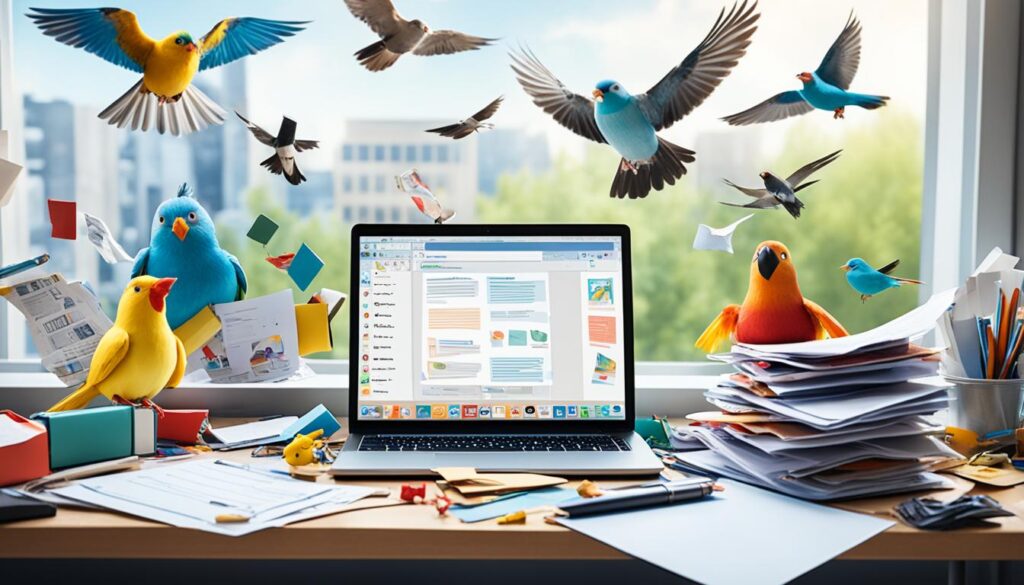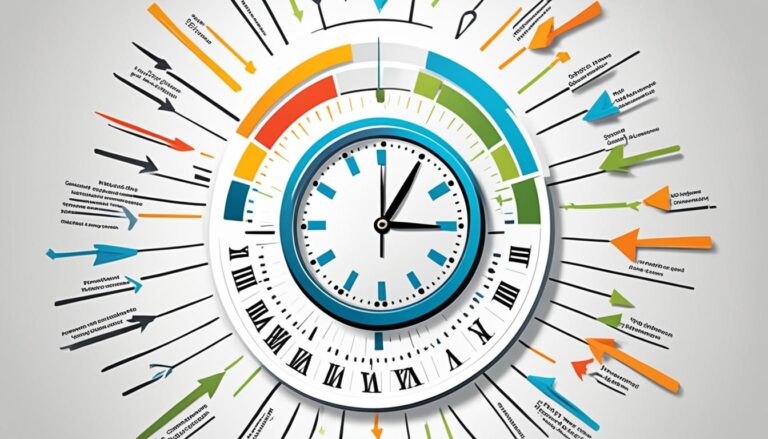Master Time Management Working from Home

Are you struggling to juggle work responsibilities and personal life while working from home? Do you feel like time slips away from you, leaving you wondering where the hours went? It’s time to take control of your productivity and master time management in a remote work setting.
Working from home offers flexibility in terms of work hours, but it requires effective time management skills to maintain productivity and work-life balance. Creating a structured routine, setting priorities, and implementing effective home office routines are key strategies for mastering time management while working remotely.
Key Takeaways:
- Create a structured routine to optimize your productivity.
- Set priorities to ensure important tasks are completed.
- Implement effective home office routines for an efficient work environment.
- Limit distractions to maintain focus on your work.
- Take regular breaks to avoid burnout and maintain productivity.
Creating a Work Structure
Creating a solid work structure is essential for managing your time effectively while working from home. Without the structure and routine that a traditional office environment provides, it’s easy to lose track of tasks and become overwhelmed. By implementing a few simple strategies, you can establish a work structure that maximizes your productivity and helps you stay on track.
1. Create a To-Do List
An effective to-do list is a powerful tool for organizing your tasks and prioritizing your work. Start each day by listing out the tasks you need to accomplish, and order them based on their importance and urgency. Break larger tasks into smaller, more manageable subtasks to make them less daunting. As you complete each task, cross it off your list for a sense of accomplishment.
2. Set Up a Work Schedule
Creating a work schedule helps to establish boundaries between your work and personal life. Designate specific hours for work and stick to them as much as possible. Mimicking a regular office schedule can help maintain a sense of routine and discipline. Block off time for breaks and lunch to ensure you’re taking necessary rest periods throughout the day.
3. Utilize Time-Tracking Software
Time-tracking software can be a valuable tool for monitoring your work hours and analyzing your productivity. It allows you to track the time spent on each task, identify areas where you may be spending too much or too little time, and make adjustments accordingly. Some popular time-tracking software options include Toggl, Harvest, and RescueTime.
Implementing these strategies will help you establish a solid work structure that enhances your productivity and ensures you stay on top of your tasks and deadlines.
| Benefits of Creating a Work Structure | Strategies for Implementation |
|---|---|
| Enhanced productivity | Create a to-do list |
| Improved time management | Set up a work schedule |
| Increased focus and efficiency | Utilize time-tracking software |
| Reduced stress and overwhelm |
Limiting Distractions at the Home Front
When working from home, distractions can be unavoidable. Social media, family members, noisy neighbors, and house chores can easily divert your attention and hinder your productivity. However, there are strategies you can implement to limit these distractions and create a focused work environment.
One effective approach is to create a separate workspace dedicated solely to work-related activities. This can be a spare room, a corner of your living room, or even a co-working space. By physically separating your workspace from the rest of your home, you can minimize distractions and create a conducive environment for concentration and productivity.
In addition to having a separate workspace, there are other practical steps you can take to minimize distractions. Consider implementing the following techniques:
- Social media management: Set boundaries and limit your use of social media during work hours. Disable notifications and use browser extensions that block access to distracting websites.
- Family members: Communicate with your family members about your work schedule and the importance of uninterrupted work time. Establish clear boundaries and create designated periods for breaks or quality time together.
- Noisy neighbors: If you’re frequently disturbed by noisy neighbors, consider using noise-cancelling headphones or investing in soundproofing materials to minimize distractions.
- House chores: Schedule specific times for completing household tasks, ensuring they don’t interfere with your work. Delegate chores to other family members or perhaps hire professional help if necessary.
By implementing these strategies, you can create a more focused and distraction-free work environment, enabling you to maximize your productivity and accomplish your tasks efficiently.
Comparison of Distraction Limiting Strategies
| Distraction | Strategy |
|---|---|
| Social media | Schedule specific times for social media use; use browser extensions to block access |
| Family members | Communicate work schedule, set boundaries, designate time for breaks or quality time |
| Noisy neighbors | Use noise-cancelling headphones, invest in soundproofing materials |
| House chores | Schedule specific time for chores, delegate tasks to family members or hire professional help |

Taking Regular Breaks
Taking regular breaks is essential for maintaining productivity and avoiding burnout while working from home. When you’re engrossed in your work, it’s easy to lose track of time and neglect the need to step away from your desk. However, incorporating regular breaks into your workday can actually enhance your overall performance and well-being.
One effective strategy is to set break reminders. Use an alarm or timer to notify you when it’s time to take a short break. This helps you stay disciplined and ensures that you don’t get caught up in your work for extended periods without giving yourself a respite.
During these breaks, consider taking a short walk. Physical activity, even for a few minutes, can help clear your mind, improve circulation, and boost your energy levels. Whether it’s a stroll around your neighborhood, a loop around your living room, or a walk up and down your stairs, the change of scenery and movement can be revitalizing.
Creating physical boundaries between your work and living spaces is another effective way to ensure you take regular breaks. Designate a specific area in your home as your workspace, and when it’s time for a break, physically leave that area. This separation helps create a mental shift and signals to your brain that it’s time to relax and recharge.
Additionally, it’s important to turn off work notifications after work hours. When emails, messages, and work-related notifications constantly pop up on your phone or computer, it can be tempting to check them during your breaks. However, this can hinder your ability to fully disconnect and rejuvenate. Set boundaries by silencing notifications or even turning off your work devices during your break time. This allows you to focus on personal activities and return to your work with renewed focus and energy.

Remember, taking regular breaks is not a sign of laziness or unproductivity. It’s a vital part of maintaining a healthy work-life balance and optimizing your performance. By prioritizing your well-being and incorporating these strategies, you’ll find yourself more energized, focused, and productive throughout your workday.
Actively Working on Productivity
When it comes to effective time management in a remote work setting, addressing productivity issues is of utmost importance. To stay ahead and maximize your productivity, there are a few key strategies that you can implement.
Utilize Time Tracking Software
One way to actively work on productivity is by utilizing time tracking software. This powerful tool allows you to analyze the duration of your tasks, identify areas where you may be spending too much time, and make adjustments accordingly. By gaining insights into your work patterns, you can optimize your time management and enhance your overall productivity.
![]()
Create Incentives and Rewards
Another effective way to stay engaged and motivated is by creating incentives for yourself. Set realistic goals and reward yourself for achieving them. These rewards can be as simple as taking short breaks or treating yourself to something you enjoy. By creating a system of incentives, you can maintain a positive mindset and drive to accomplish your tasks efficiently.
Addressing Productivity Issues Early
Don’t let productivity issues linger and impact your work. Instead, take a proactive approach by addressing them early on. Reflect on your work habits, identify any challenges, and explore solutions that can help you overcome these obstacles. By actively working on improving your productivity, you can ensure that you stay on track and make the most of your working hours.
Accepting More Accountability
As a remote worker, one of the key factors in achieving success is accepting accountability for your work performance. When you take ownership of your responsibilities and actions, you have the power to make a significant impact on your productivity and overall work satisfaction.
Setting Clear Goals
A crucial aspect of accepting accountability is setting clear goals. By establishing specific, measurable, attainable, relevant, and time-bound (SMART) objectives, you can focus your efforts and track your progress effectively. Whether it’s daily, weekly, or monthly goals, they provide a roadmap towards your desired outcomes and help you stay on track.
Maintaining Clear and Open Communication
Clear and open communication with your team members is essential for fostering accountability. Regularly update your teammates on your progress, discuss any challenges you encounter, and seek their support and feedback. By keeping the lines of communication open, you create an environment that promotes teamwork and collaboration.
Utilizing Productivity Monitoring Tools
To ensure accountability, consider utilizing productivity monitoring tools. These tools help you track your time, measure your productivity levels, and identify potential areas for improvement. By having visibility into your work habits and efficiency, you can make informed decisions on how to optimize your performance.

Taking Ownership of Work
When accepting accountability, it is crucial to take ownership of your work. This means seeing tasks through completion, taking responsibility for the outcomes, and continuously seeking ways to enhance your skills and knowledge. By taking ownership, you empower yourself to make positive changes and drive your success.
By embracing accountability, setting clear goals, maintaining clear communication, utilizing productivity monitoring tools, and taking ownership of your work, you can enhance your productivity, effectiveness, and overall job satisfaction as a remote worker.
Conclusion
Managing your time effectively while working from home is essential for maximizing productivity and maintaining a healthy work-life balance. By implementing practical strategies and utilizing the right tools, you can master time management in a remote work environment.
Creating a structured work routine is the first step towards effective time management. Build a work structure by setting priorities, creating a to-do list, and devising a work schedule that mirrors a traditional office environment. This will help you stay organized and focused on essential tasks.
Additionally, it is crucial to limit distractions at the home front. Whether it’s social media, family members, or external noises, creating a separate workspace and setting physical boundaries between your work and personal life can help minimize interruptions and improve concentration.
Remember to incorporate regular breaks into your workday. Taking short walks, setting break reminders, and turning off work notifications after work hours will rejuvenate your mind and prevent burnout, ultimately boosting your productivity.
Furthermore, actively working on productivity is key to managing your time effectively. Identify and address productivity hurdles promptly by utilizing time tracking software, analyzing task duration, and creating incentives to stay motivated and engaged.
Lastly, embrace accountability for your work performance. Set clear goals, maintain open communication with your team, and take ownership of your work. By accepting accountability and utilizing productivity monitoring tools, you can continuously improve your performance and achieve optimal results.
With these time management strategies and work-life balance techniques, you are equipped to thrive in a remote work environment. By prioritizing your tasks, limiting distractions, taking regular breaks, actively working on productivity, and embracing accountability, you can achieve a harmonious balance between work and personal life, ensuring success and well-being as you work from home.
FAQ
How can I create a work structure while working from home?
You can create a work structure by creating a to-do list to prioritize tasks, setting up a work schedule that mimics a regular office environment, and using time-tracking software to track task duration and improve productivity.
How can I limit distractions at home while working remotely?
To limit distractions, you can minimize social media usage, avoid interruptions from family members, deal with noisy neighbors, and delegate or schedule house chores. Creating a separate workspace or utilizing co-working spaces can also help create a physically separate environment for work, minimizing distractions and improving focus.
How can I incorporate regular breaks into my workday while working from home?
You can incorporate regular breaks into your workday by setting break reminders, taking short walks, creating physical boundaries between work and living spaces, and turning off work notifications after work hours. These strategies will help you maintain productivity and avoid burnout.
What can I do to actively work on improving my productivity while working remotely?
To actively work on improving productivity, you can address productivity issues early on, utilize time tracking software to analyze task duration and identify areas for improvement, and create incentives to stay engaged and motivated in your work.
How can I accept more accountability for my work performance while working from home?
You can accept more accountability for your work performance by setting clear goals, maintaining clear and open communication with your team members, utilizing productivity monitoring tools, and taking ownership of your work to continuously improve your performance.






